Can supersonic dreams survive the global warming age?
- Published
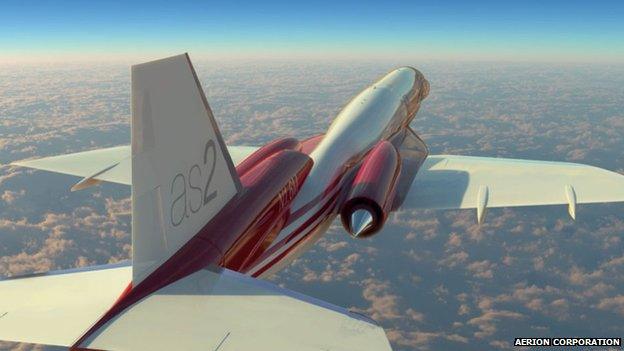
The wings of the Aerion as2 concept business jet are designed to reduce air friction at supersonic speeds
When Concorde swooshed across the Atlantic at supersonic speeds of 1,350mph (2,170km/h), you could fly from London to New York in under four hours.
It seemed as if the glamorous age of superfast aviation was here to stay.
But Concorde was costly, noisy and thirsty on fuel, and was withdrawn from service in 2003, external, some 36 years after the first prototype rolled out of the hangar.
So will supersonic passenger flight ever make a comeback?
The sad truth for speed freaks is that reducing carbon dioxide emissions, rather than increasing speed, has become the new imperative for the aviation industry amid widespread concerns about global warming.
This means most of the innovation is happening in the fields of engine efficiency, aerodynamics and cabin comfort.
Greening flight
Modern passenger jets are very different beasts compared to their forebears, despite their basic shapes remaining remarkably similar.
They now feature much more sophisticated avionics, lightweight composite materials, and engines that are 90 times more powerful than their 1940s predecessors, yet 70% more fuel-efficient.
They are also a lot safer.
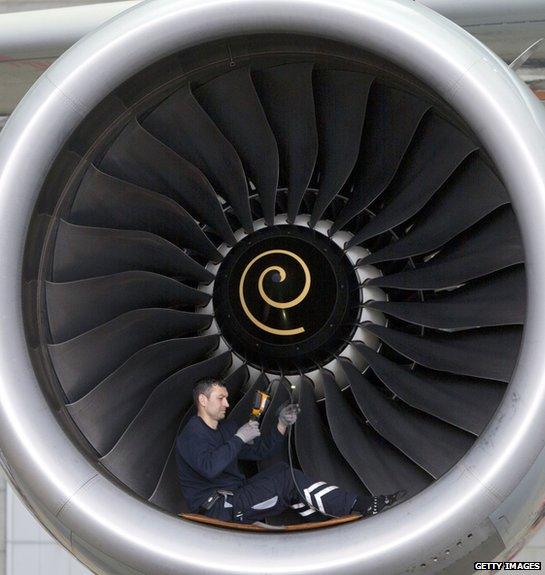
Jet engines are now 70% more fuel-efficient than the original versions
Manufacturers, such as Rolls-Royce, General Electric and Pratt & Whitney, believe there's plenty more efficiency to be squeezed out of the turbofan jet engine over the coming decades.


Tomorrow's Transport is a series exploring innovation in all forms of future mobility.

"Our new Advanced engines coming in 2020 will incorporate carbon fibre blades with a titanium edge to counter the increased weight of the bigger engines," says Alan Newby, Rolls-Royce's chief engineer, future programmes and technology.
Engines are getting bigger to allow more air to flow through but at slower speeds, improving fuel efficiency and reducing noise, says Mr Newby.
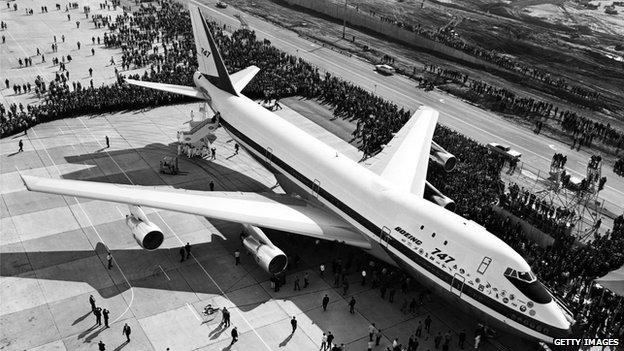
This 1968 Boeing 747 doesn't look too dissimilar...
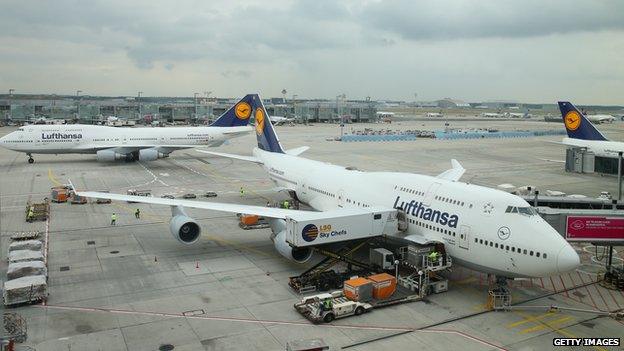
...to Boeing 747s of today, but there are big differences "under the bonnet"
New materials, such as "ceramic matrix composites" and "single crystal turbine alloys", will allow engines to run at higher temperatures - in excess of 2,200C (4,000F) in some cases - which also improves efficiency.
"Subsonic [under 761mph] is definitely going to be with us for a long, long time, because a driver of the future is the impact on the environment," says Prof Jeff Jupp, fellow of the Royal Aeronautical Society.
Electric skies
Airlines, like car manufacturers, are also looking towards hybrid engines as a way of reducing emissions.
Nigel Cassidy looks at an all-electric plane on display at the Farnborough Airshow
"In the future, there is the possibility of electric propulsion, with a gas-powered engine driving the generator to create electricity," says Prof Jupp. "Batteries would be included as a back-up for the turbofans."
In 2014, Airbus showed off an all-electric E-Fan training plane, but large-scale electric passenger planes are unlikely unless batteries can be made a lot lighter, experts believe.
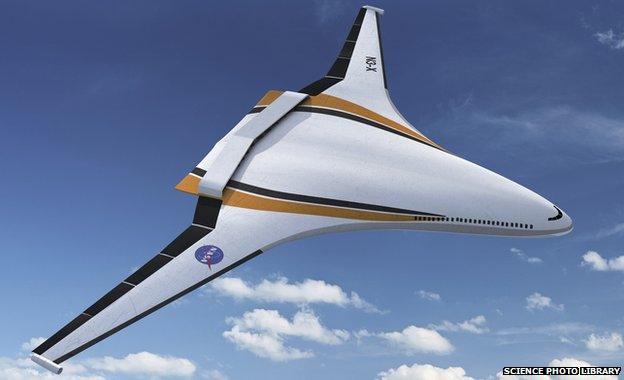
Aerodynamic "blended wing" concepts, like Nasa's N3-X, could reduce noise, emissions and fuel burn
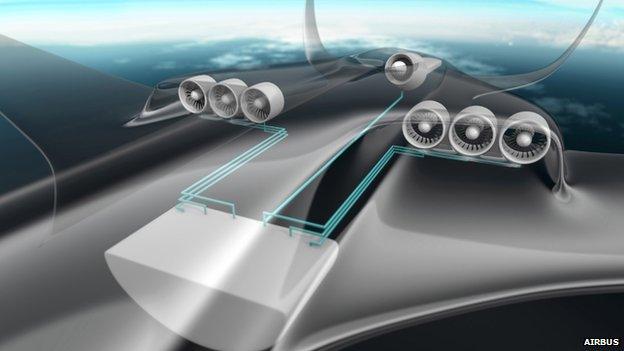
Airbus's concept "electrical distributed fan" propulsion system could also reduce drag and emissions
Such hybrid engines distributed across new aerodynamic body shapes, such as the "blended" or "flying" wing, could improve fuel efficiency even further, says Prof Jupp.
Boeing, Nasa and others have been experimenting with blended wing concepts, which can reduce a plane's total surface area by 25% to reduce drag and save fuel.
They are not without problems, however - the lack of tail fin makes them inherently less stable - but fly-by-wire computers could help iron this out, engineers believe.
Are you sitting comfortably?
Perhaps the most radical innovation in aviation, though, is happening inside the cabin.
For example, Spike Aerospace has talked about getting rid of windows completely and replacing them with digital screens relaying camera images of the view outside or any other media the passenger wants.
Removing windows would reduce the weight of the aircraft and improve aerodynamics, the company believes.
And the general trend is towards wireless connectivity and interactive displays, says Jared Shoemaker of BAE Systems, although this will present extra security challenges.
"Traditionally, cabins have been closed worlds not connected to anything outside," says Mr Shoemaker, director of cabin systems.
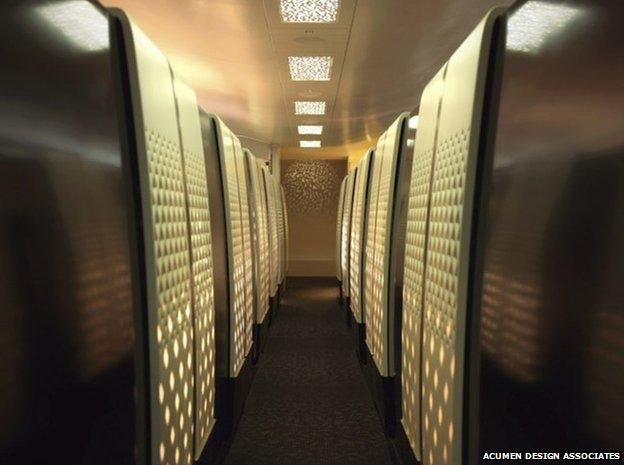
In these luxury suites for Etihad Airways you could forget you were on a plane
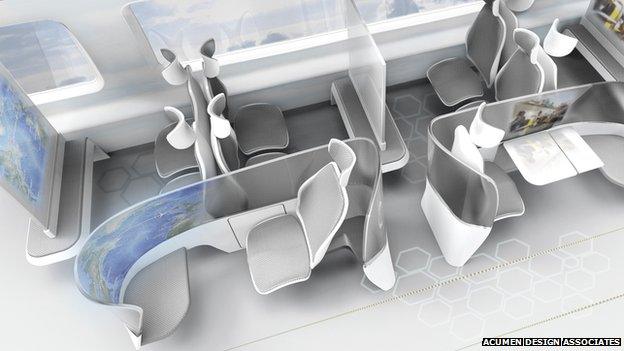
Economy class could become more luxurious once planes go wireless, believes Acumen Design
"But now it's all about connectivity and interacting with the crew and other passengers through personal devices."
Removing heavy wires will save weight and allow for more innovative cabin layouts, argues Anthony Harcup of Acumen Design Associates, the company behind the Airbus A380's interior.
"The next big revolution will be creating true comfort in economy," he says.
New smart materials will allow passengers to take complete control of their environments, setting lighting and heating levels, for example, while seats will mould themselves to your body shape, he believes.

Airbus envisages radical new structures and materials for future cabins
Airbus even envisages aircraft skin that can become transparent, allowing passengers to see outside.
"In 20 years the jet will look remarkably similar but the passenger experience will be completely different," says Mr Shoemaker.
"Flexible displays and projections will make you feel you're not walking into a tube, but a much softer, bigger space. Whatever you can do in your living room you'll be able to do on a plane."
Need for speed
Not everyone has given up on the dream of supersonic flight, however.
Some companies, such as Spike Aerospace, Aerion Corporation and Hypermach, have said they're developing supersonic jets aimed at the business market.
But to date, none has taken to the skies.
The problem with travelling much faster than the speed of sound is that air friction can increase surface temperatures to well over 1,000C (1,830F), putting huge strains on aircraft materials. Shockwaves are also an issue.
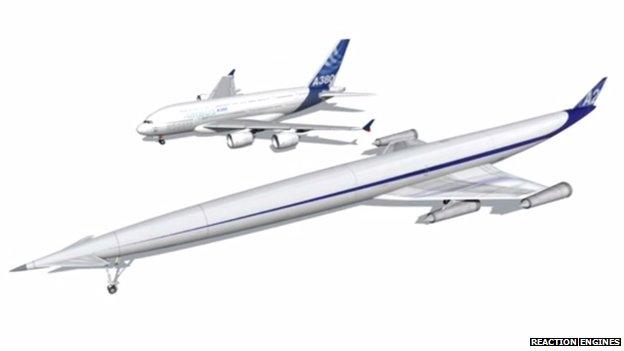
Reaction Engines' Lapcat 2 hydrogen-powered passenger jet would need very large fuel tanks
And travelling at such speeds uses a lot more fuel and creates a lot more noise, which is why supersonic flight is banned over populated areas.
But if supersonic flight seems less of a priority these days, the prospects for hypersonic (more than five times the speed of sound) seem vanishingly small.

Know your speeds
Speed of sound: Mach 1 or 761mph (1,225km/h) at sea level
Subsonic: below Mach 1
Supersonic: above Mach 1
Hypersonic: Mach 5 (five times the speed of sound) and above

"Realistically we're not going to see the first hypersonic passenger plane for another 20 years," says Alan Bond, chief executive of Reaction Engines, whose company specialises in hydrogen-fuelled rocket engines.
Easy access to space may happen sooner than that, he believes.
Nasa has demonstrated the feasibility of air-breathing scramjet, external [supersonic combustion ramjet] engines capable of hypersonic speeds.
In 2009, its unmanned X-43A jet blasted to nearly Mach 10. And in 2010, the X-51A maintained a speed of more than Mach 5 for more than 200 seconds, external.
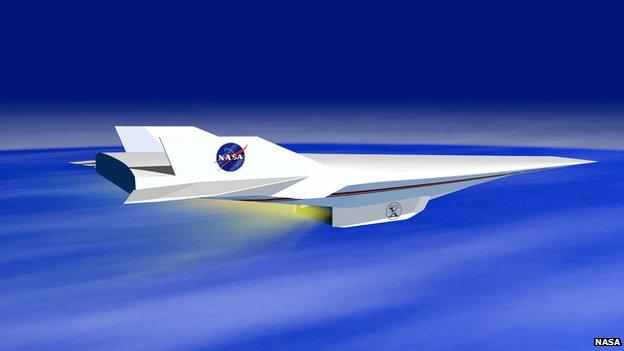
Nasa hopes its scramjet can power unmanned aircraft up to Mach 10
But designing a craft that can survive such speeds and temperature extremes for any length of time is proving extremely difficult.
Reaction Engines' Sabre rocket, which can switch from air-breathing mode to one that uses liquid oxygen to burn hydrogen at very high speeds and altitudes, has been given the thumbs up by the European Space Agency.
"We're working towards a demonstration Sabre engine by 2019," says Mr Bond.
But development will require hundreds of millions of pounds, he believes, and passenger aircraft powered by such engines would have to have huge fuel tanks, since hydrogen is a very low-density gas.
"Supersonic travel is possible but the jury is out on hypersonic travel - the costs are just too high," says Prof Jupp.
"Some people may be prepared to pay an exorbitant amount for the tickets, but it is likely to be a very niche market."